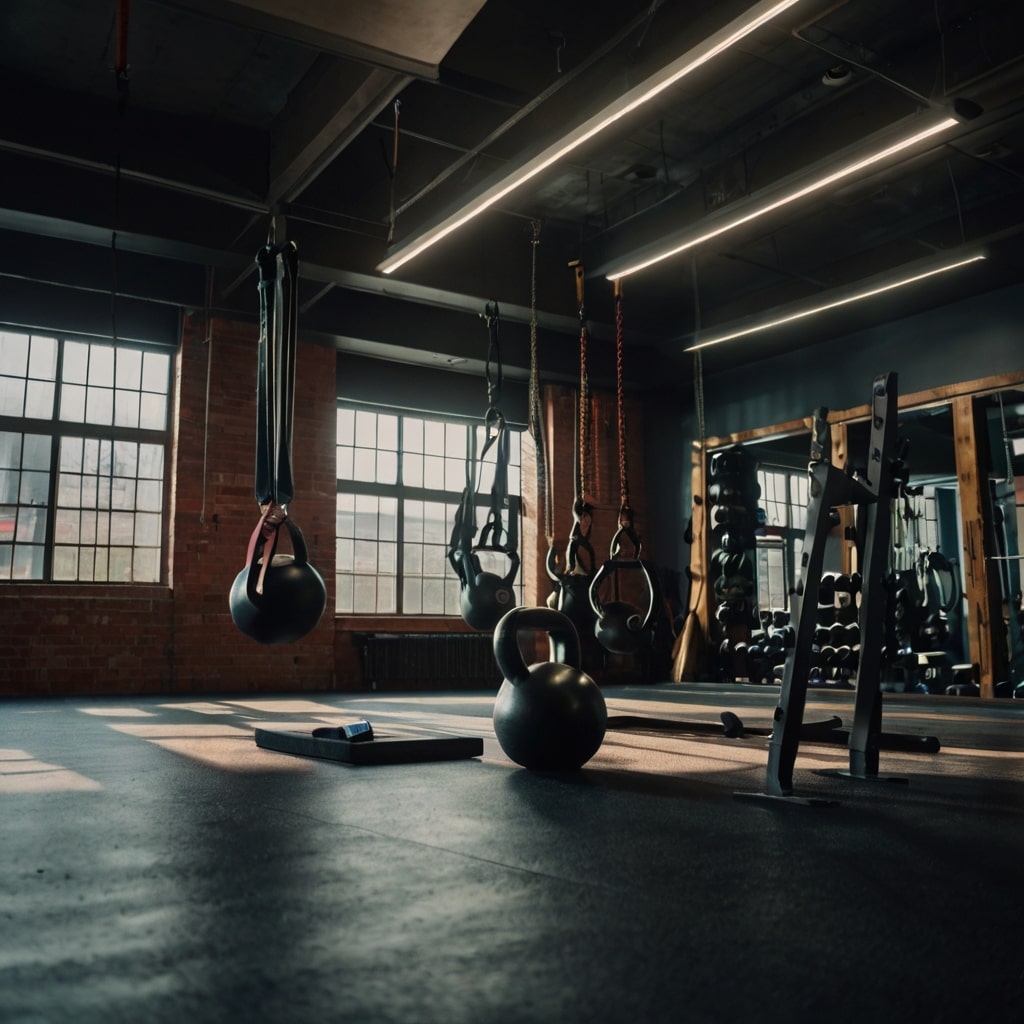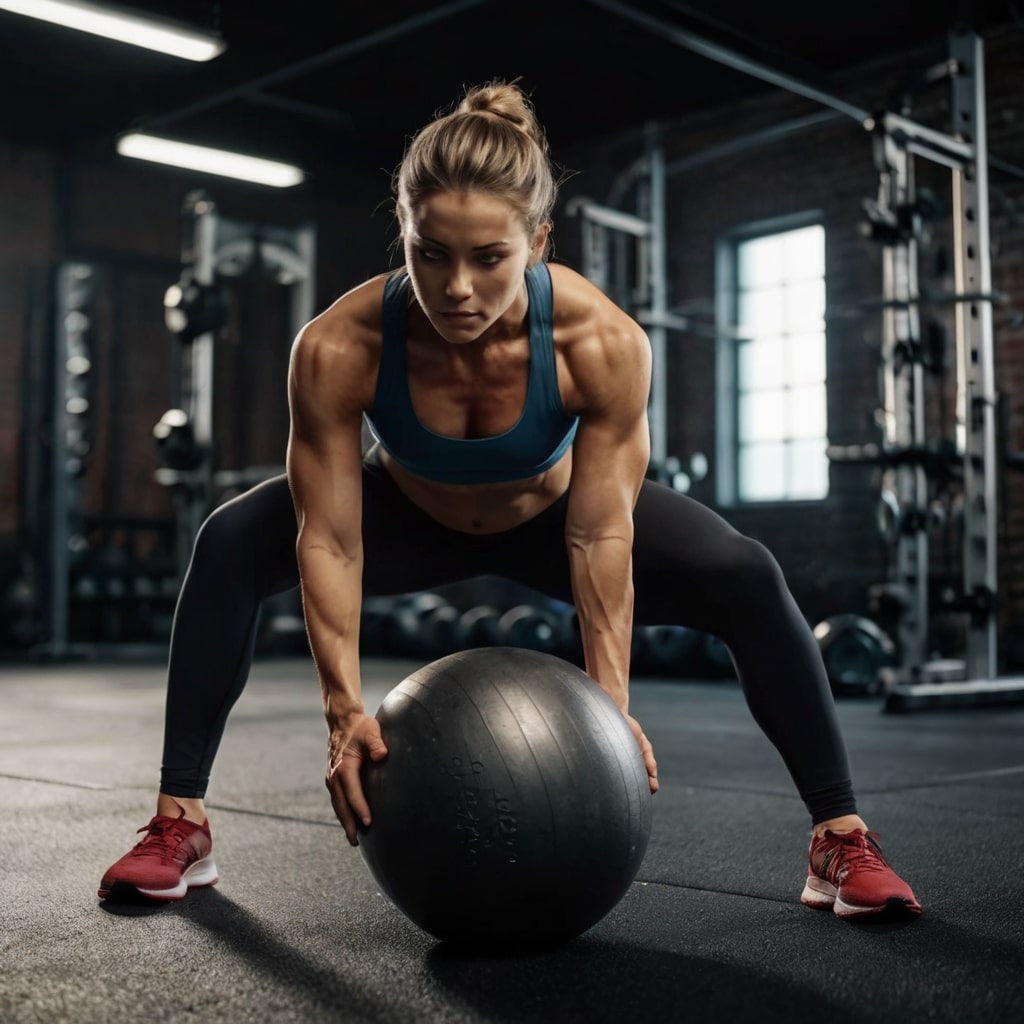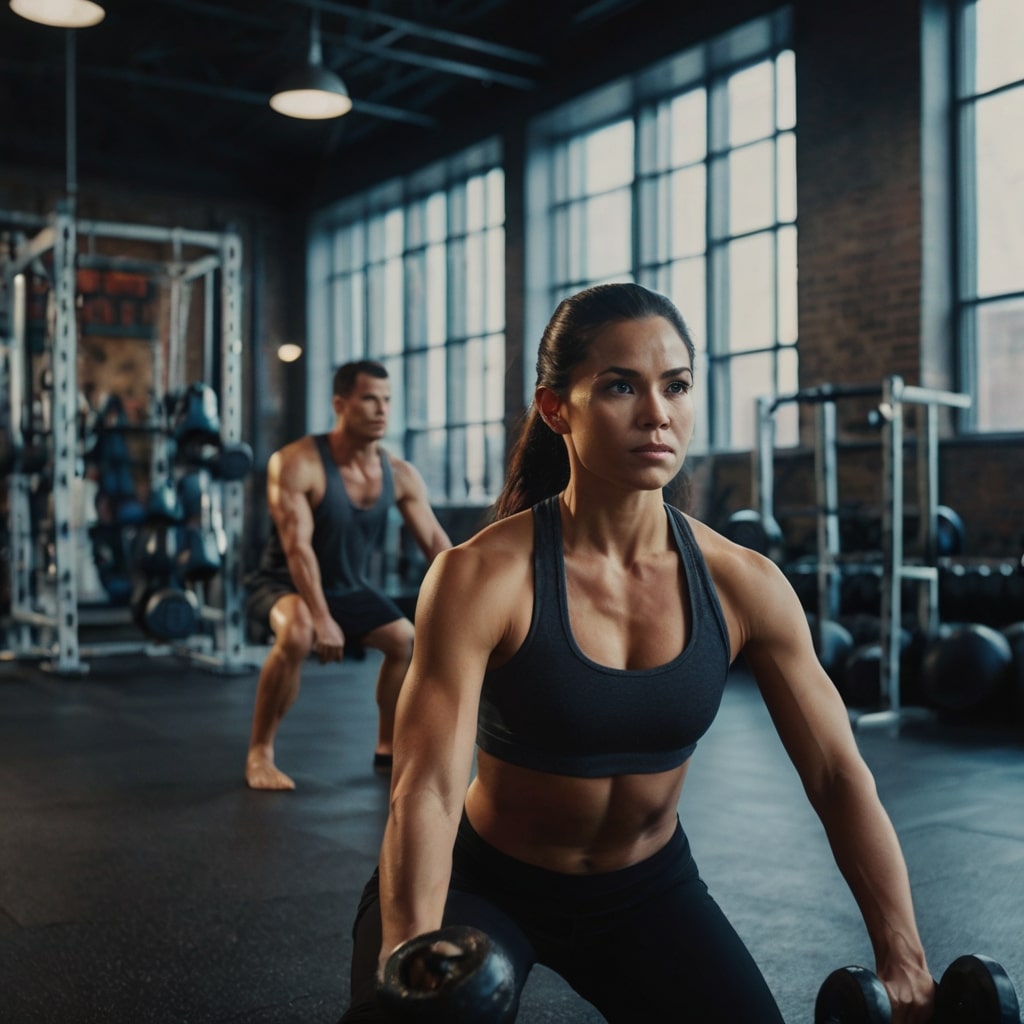You’re stuck inside, and your workout routine is getting stale.
The same old gym sessions aren’t cutting it anymore – no matter how hard you push yourself on the treadmill or lift those heavy weights. You feel like you’re not seeing any real progress.
What if I told you there’s a way to transform your body, boost your mood, and get fit without sacrificing style?
Let me show you how!
Building Strength and Power with Bodyweight Exercises
Jumping into it, building strength and power with bodyweight exercises is a fantastic way to unlock your potential for an effective indoor fitness routine. Let’s dive in!
When you start exercising without equipment, the first thing that might come to mind is push-ups and squats – and rightfully so! These fundamental movements are essential for strengthening the upper body and lower body respectively. But there’s more where that came from.
One exercise to focus on is inverted rows using a towel or resistance band. This movement targets your latissimus dorsi muscles, which can help improve posture, increase pulling power, and even enhance overall athletic performance.
Next up are single-leg squats – these exercises work wonders for improving balance, stability, and strengthening those hard-to-reach leg muscles. And let’s not forget about planks! A well-executed plank strengthens the entire core region while also engaging your shoulders, back, and glutes.

Finally, incorporating burpees into your routine can be incredibly effective in boosting strength and power. These full-body exercises engage almost every muscle group at once – think chest, shoulders, triceps, quadriceps, hamstrings… you get the idea!
The key to success lies not only in mastering these movements but also in consistently challenging yourself with progressive overload and varying your routine.
Using Resistance Bands to Enhance Mobility and Flexibility
Resistance bands are a fantastic way to boost your mobility and flexibility while working out from the comfort of your own home.
The main reason resistance bands can help with this is because they provide continuous tension throughout the entire range of motion. This means you can work on both strengthening and stretching simultaneously, which is particularly useful for improving flexibility.
For instance, when using a resistance band to perform a leg curl, you’ll feel the stretch in your hamstrings as well as the contraction in your quadriceps. The continuous tension allows you to focus on controlled movements and precise positioning without worrying about sudden releases of force that can be detrimental to joints.
Another benefit of incorporating resistance bands into your workout is their portability and convenience. They’re lightweight, compact, and easy to store away when not in use.
You can take them with you on-the-go or stash them under a bed for quick access whenever the mood strikes. This makes it easier to fit exercise into even the busiest of schedules without having to rely on bulky equipment that takes up valuable space at home or requires trips to the gym.
Mastering Kettlebell Swings for Explosive Movements
Mastering Kettlebell Swings for Explosive Movements requires a combination of proper technique and controlled motion.
The foundation is building strength in your core, legs, and glutes. This will allow you to generate power and speed as you swing the kettlebell.
For example, engage your core by drawing your belly button towards your spine while keeping your chest up. Keep your knees slightly bent to maintain balance throughout the movement.
Aiming for a smooth, controlled swing is crucial in achieving explosive movements. Avoid jerky or forced motions that can put unnecessary stress on your joints.
To achieve this, focus on using your hips and legs to drive the kettlebell’s motion instead of relying solely on arm strength. As you swing the kettlebell back between your legs, keep it close to your body and engage your core muscles for stability. Extend your arms fully as you swing forward, maintaining control throughout.
By building a strong foundation in your lower body and using controlled movements, you’ll be able to generate explosive power with each kettlebell swing. This will translate into improved overall fitness performance and enhanced functional strength.
The Importance of Core Strengthening in Functional Training
Functional training exercises are essential for an effective indoor fitness routine because they help strengthen the core muscles.
Your core is made up of several muscle groups, including your abs, obliques, and lower back. When these muscles are weak or imbalanced, it can lead to poor posture, decreased athletic performance, and even increase your risk of injury.
For instance, if you have a weak set of core muscles on one side of your body compared to the other side, this imbalance can cause you to lean or rotate in certain directions. This is especially true when performing exercises that involve twisting or turning motions like golf swings, tennis serves, and soccer kicks.
Functional training exercises also help improve coordination and balance by strengthening the connections between different muscle groups.
Take for instance a exercise that involves holding a plank position while simultaneously lifting one leg off the ground. This type of exercise requires engagement of your core muscles to maintain stability, as well as coordination between your legs and hips to lift one leg without losing balance.
Adding Cardiovascular Intensity with High-Intensity Interval Training (HIIT)
High-Intensity Interval Training, or HIIT for short, is an efficient way to boost your cardiovascular intensity while adding variety and excitement to your indoor fitness routine.
The main reason HIIT is so effective lies in its unique combination of intense exercise periods followed by brief periods of rest. This interval training style has been shown to be incredibly challenging yet surprisingly time-efficient, making it an excellent addition to any workout regimen.
For instance, a 20-second all-out sprint on the treadmill is immediately followed by two minutes of active recovery – perhaps some light jogging or walking in place. This pattern can be repeated for anywhere from 15-30 minutes depending on your fitness level and goals.
Another advantage HIIT offers is its ability to simulate real-world scenarios, making it a fantastic way to improve functional strength and endurance. By mimicking the intensity and pace of daily activities such as running up stairs or quickly changing direction while playing sports, you’ll be better equipped to handle life’s challenges.
Imagine sprinting across a busy street during your morning commute or quickly dodging pedestrians on your lunch break walk – HIIT can help prepare you for these types of situations by training your body to adapt to sudden changes in intensity and direction.
How Plyometric Exercises Can Improve Power and Agility
Plyometric exercises are a crucial part of any fitness routine that aims to improve power and agility.
The concept behind plyometrics is simple: by explosively contracting your muscles, you can generate tremendous force. This is achieved through the use of rapid movements and high-velocity contractions.
For instance, when doing a jump squat exercise, you start in a low position with your hands on the floor then quickly explode upwards while keeping your arms straight. As you reach the top of your movement, you absorb some of that energy by bending your knees and hips to reduce impact. This rapid contraction and absorption is what makes plyometrics so effective at improving power.
Incorporating plyometric exercises into your routine can also help with agility training because it forces you to react quickly in different directions. The more explosive movements become second nature, the better equipped you are to change direction rapidly without losing speed or control.
A great example of this is the lateral hop exercise where you start facing forward and then explosively jump sideways while keeping your arms out for balance. As you land from that movement, quickly switch directions by jumping in another new direction. By incorporating movements like these into your workout routine, you can significantly improve agility.
Creating a Full-Body Workout Routine for Indoor Fitness Success
A full-body workout routine is a must-have for any indoor fitness enthusiast who wants to unlock their true potential and achieve effective results.
The key to creating such a routine is incorporating exercises that target multiple muscle groups at once, while also providing adequate rest time in between sets. This ensures maximum efficiency and minimizes the risk of overtraining or injury.
For instance, squats not only work your legs but also engage your core muscles for added stability. Similarly, push-ups work multiple upper body muscle groups simultaneously, including chest, shoulders, and triceps.
Another crucial aspect to consider is the incorporation of compound exercises that stimulate growth hormone production and increase overall muscle mass.

These include exercises like deadlifts, bench press, and rows. By incorporating these movements into your routine, you’ll not only build strength but also boost your metabolism and burn calories more efficiently.
Overcoming Plateaus with Progressive Overload and Variations
Plateaus are a natural part of any fitness journey, but they can be frustrating. You’ve been consistently working out, yet you’re not seeing the improvements you want. The problem is that your body has adapted to the same exercises and weight amounts, making them less effective.
The lack of progression in your workouts means you’re no longer challenging yourself enough to achieve significant gains. Your muscles have become too comfortable with the movements, which can lead to stagnation and decreased motivation.
For instance, if you’ve been doing the same bicep curl exercise for months, your body has likely adapted by strengthening those specific muscle fibers. However, this means other areas of your arms may be underdeveloped or neglected.
The solution lies in progressive overload – gradually increasing the intensity of your workouts to continue challenging yourself and promoting growth. This can be achieved through variations in exercises, increased weight, or even altered ranges of motion.
Try changing the grip on a deadlift to increase engagement from different muscle groups or incorporating single-leg squats to target balance and stability. You can also gradually add more weight over time as your body adapts. The key is to continually challenge yourself and find new ways to engage your muscles.
By incorporating progressive overload into your indoor fitness routine, you’ll be able to break through plateaus and achieve the results you’ve been striving for. Experiment with different exercises and variations to keep challenging yourself, and watch as your progress accelerates.
The Role of Balance and Coordination in Functional Training
Functional training exercises aim to improve your overall physical fitness by mimicking daily activities and movements in a more effective way.
Balance and coordination are crucial elements in functional training. They help you maintain stability, control, and precision while performing various exercises.
For instance, balance is essential when doing squats or lunges as it enables your body to adjust its position accordingly. This prevents unwanted movements that can lead to injuries.
Coordination plays a significant role in functional training by enabling you to link different movements seamlessly. When done correctly, coordination helps create a fluid movement pattern that enhances overall performance and efficiency.
A great example of this is when performing exercises like burpees or jump squats. These moves require precise timing and synchronization between the legs, arms, and core muscles to maintain control throughout the entire motion.
Designing an Effective Warm-Up and Cool-Down Protocol
A well-designed warm-up and cool-down protocol is essential for an effective indoor fitness routine. It prepares your body for physical activity, reduces the risk of injury, and helps with recovery.
To start your workout on a strong note, begin with gentle cardio exercises that get your blood flowing. This can include light jogging in place or jumping jacks.
For instance, 30 seconds to one minute of easy burpees followed by 30 seconds of rest will get you moving without exhausting you too quickly.
After your workout, a proper cool-down is just as important. This helps slow down your heart rate and reduce muscle soreness.
Finish with static stretches that target the major muscle groups used during exercise. For example, spend 20-30 seconds stretching each leg for quadriceps and hamstrings.
By incorporating these functional training exercises into your indoor fitness routine, you’ll be on your way to a stronger, more resilient self. Remember to prioritize a well-designed warm-up and cool-down protocol to optimize your workout results. With consistent practice, you’ll find yourself feeling more energized and confident in no time.
Taking Your Indoor Fitness to the Next Level with Functional Training
Great fitness results won’t come from stagnant routines.
The best exercise plans are those that challenge you, push you outside of your comfort zone, and force you to adapt. Functional training exercises do just that – they work multiple muscle groups at once, mimicking the movements we use every day in real life.
By incorporating functional training into your indoor fitness routine, you’ll not only see improvements in strength and flexibility but also enhanced coordination and balance. The more efficient and effective your workouts become, the more time you’ll have to focus on other areas of your life.
Take decisive action today to unlock a stronger version of yourself through functional training exercises that will revolutionize your indoor fitness routine.




